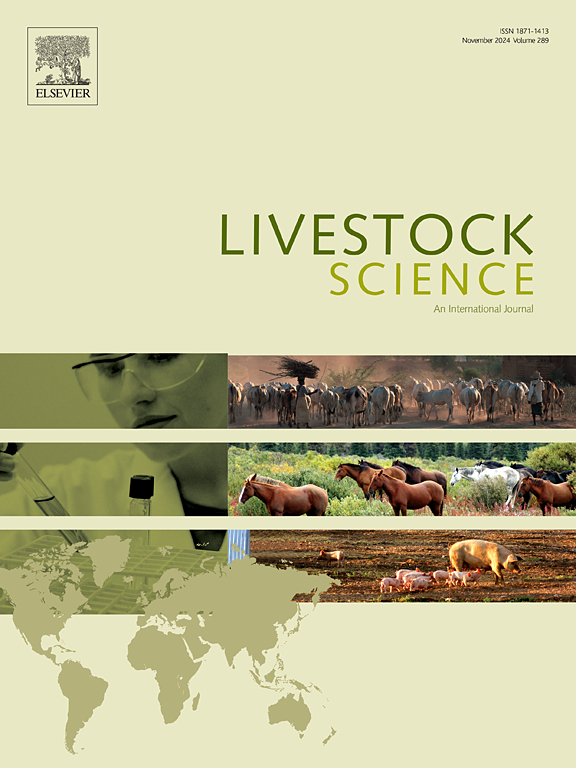Focused high-protein supplementation to ewes grazing Campos grassland during mid gestation improves maternal-fetal blood flow and skeletal muscle mass of the progeny
IF 1.9
3区 农林科学
Q2 AGRICULTURE, DAIRY & ANIMAL SCIENCE
引用次数: 0
Abstract
In order to evaluate the effect of focused-high-protein supplementation during the second third of gestation on placentome and uterine artery blood flow, growth and carcass composition of the progeny, 37 single-bearing ewes were used. Campos grazing ewes were divided in two nutritional treatments between 55 and 80 days of gestation: supplemented ewes (SUP; n = 22, 12 carrying female and ten carrying male fetuses) were individually daily supplemented with soybean meal at 1 % of their body weight (BW), and control ewes (CON; n = 15, nine carrying female and six carrying male fetuses) grazed adjoining Campos sub paddock without supplementation. After 80 days of pregnancy all ewes were managed together as the same flock and continued grazing on the same paddock of Campos grassland until 100 days of pregnancy when they were sheared and transferred to a multi-year pasture until lambing. Doppler ultrasonography examinations of placentome and uterine artery blood flow were performed on day 120 of pregnancy. Maternal supplementation reduced the resistance index value (P = 0.042) and tended to reduce the diastole/systole ratio (P = 0.078) in placentomes. Similarly, in the uterine artery, maternal supplementation reduced both the resistance index value (P = 0.022) and the diastole/systole ratio (P = 0.030). On the other hand, maternal supplementation did not affect lamb´s BW, body morphometric measurements or lamb´s weight gain from birth to 90 days of age (P > 0.05). Similarly, organs’ weight and carcass objective conformation traits were not affected by maternal supplementation at slaughter (90-day-old lambs, P > 0.05). Nevertheless, muscle weight expressed as a percentage of lamb BW was higher in SUP than in CON lambs (P = 0.007). Also, absolute muscle weight tended to be affected by the interaction between maternal supplementation and the sex of the lambs (P = 0.072), as male lambs born to SUP ewes had heavier muscles than CON male lambs (P = 0.059). In summary, focused high-protein supplementation offered to ewes grazing Campos grassland during the second third of gestation positively affected placentome and uterine artery blood flow but had no effect on lamb growth traits. However, our results indicate that maternal supplementation improved the BW proportion of muscles. Also, our results suggest that maternal supplementation could have influenced skeletal muscle development in a sex-specific manner, although under the conditions of the present experiment this effect was subtle and depended on the BW of the lamb.
在妊娠中期对放牧坎波斯草原的母羊集中补充高蛋白可改善母胎血流量和后代的骨骼肌质量
为了评价妊娠第二、三分之一阶段集中补充高蛋白对子代胎盘和子宫动脉血流、生长和胴体组成的影响,本试验选用单胎母羊37只。在妊娠55 ~ 80天,将坎波斯放牧母羊分为两种营养处理:补充母羊(SUP);n = 22,雌性胎12只,雄性胎10只),每天单独添加1%体重(BW)的豆粕,对照母羊(CON;n = 15, 9只携带雌性胎儿,6只携带雄性胎儿)在毗邻的Campos子围场放牧,没有补充。怀孕80天后,所有母羊作为同一群一起管理,继续在坎波斯草原的同一围场放牧,直到怀孕100天,剪毛后转移到多年牧场直到产羔。妊娠第120天行多普勒超声检查胎盘及子宫动脉血流。母体的添加降低了胎盘的阻力指数(P = 0.042),并有降低舒张/收缩比的趋势(P = 0.078)。同样,在子宫动脉中,母体的添加降低了阻力指数值(P = 0.022)和舒张/收缩比(P = 0.030)。另一方面,母源添加不影响羔羊出生至90日龄的体重、体形态测量和羔羊增重(P >;0.05)。同样,在屠宰时,母羊添加物对器官重量和胴体客观构象性状没有影响(90日龄羔羊,P >;0.05)。然而,肌肉重量占羔羊体重的百分比SUP组高于CON组(P = 0.007)。此外,绝对肌肉重量倾向于受母羊添加量和羔羊性别的相互作用影响(P = 0.072), SUP母羊所生的雄性羔羊肌肉比CON母羊重(P = 0.059)。综上所述,在妊娠2 / 3期放牧坎波斯草原的母羊中,有针对性地补充高蛋白对胎盘和子宫动脉血流有积极影响,但对羔羊的生长性状没有影响。然而,我们的研究结果表明,母体的补充提高了肌肉的体重比例。此外,我们的研究结果表明,母本添加物可能以性别特异性的方式影响骨骼肌的发育,尽管在本实验条件下,这种影响是微妙的,取决于羔羊的体重。
本文章由计算机程序翻译,如有差异,请以英文原文为准。
求助全文
约1分钟内获得全文
求助全文
来源期刊

Livestock Science
农林科学-奶制品与动物科学
CiteScore
4.30
自引率
5.60%
发文量
237
审稿时长
3 months
期刊介绍:
Livestock Science promotes the sound development of the livestock sector by publishing original, peer-reviewed research and review articles covering all aspects of this broad field. The journal welcomes submissions on the avant-garde areas of animal genetics, breeding, growth, reproduction, nutrition, physiology, and behaviour in addition to genetic resources, welfare, ethics, health, management and production systems. The high-quality content of this journal reflects the truly international nature of this broad area of research.
 求助内容:
求助内容: 应助结果提醒方式:
应助结果提醒方式:


